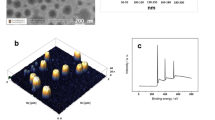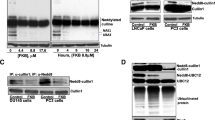Abstract
Boron (B) is a developmental and reproductive toxin. It is also essential for some organisms. Plants use uptake and efflux transport proteins to maintain homeostasis, and in humans, boron has been reported to reduce prostate cancer. Ca2+ signaling is one of the primary mechanisms used by cells to respond to their environment. In this paper, we report that boric acid (BA) inhibits NAD+ and NADP+ as well as mechanically induced release of stored Ca2+ in growing DU-145 prostate cancer cells. Cell proliferation was inhibited by 30% at 100μM, 60% at 250μM, and 97% at 1,000μM BA. NAD+-induced Ca2+ transients were partly inhibited at 250μM BA and completely at 1,000μM BA, whereas both NADP+ and mechanically induced transients were inhibited by 1,000μM BA. Expression of CD38 protein increased in proportion to BA exposure (0–1,000μM). In vitro mass spectrometry analysis showed that BA formed adducts with the CD38 products and Ca2+ channel agonists cyclic adenosine diphosphate ribose (cADPR) and nicotinic acid adenine dinucleotide phosphate (NAADP). Vesicles positive for the Ca2+ fluorophore fluo-3 acetoxymethyl ester accumulated in cells exposed to 250 and 1,000μM BA. The BA analog, methylboronic acid (MBA; 250 and 1,000μM), did not inhibit cell proliferation or NAD+, NADP+, or mechanically stimulated Ca2+ store release. Nor did MBA increase CD38 expression or cause the formation of intracellular vesicles. Thus, mammalian cells can distinguish between BA and its synthetic analog MBA and exhibit graded concentration-dependent responses. Based on these observations, we hypothesize that toxicity of BA stems from the ability of high concentrations to impair Ca2+ signaling.






Similar content being viewed by others
References
Allen BC, Strong PL, Price CJ, Hubbard SA, Daston GP. Benchmark dose analysis of developmental toxicity in rats exposed to boric acid. Fundam Appl Toxicol. 1996;232:194–204.
Abeele FV, Shuba Y, Roudbaraki M, Lemonnier L, Vanoverberghe K, Mariot P, et al. Store-operated Ca2+ channels in prostate cancer epithelial cells: function, regulation, and role in carcinogenesis. Cell Calcium. 2003;33:357–73.
Armstrong TA, Spears JW, Crenshaw TD, Nielsen FH. Boron supplementation of a semipurified diet for weanling pigs improves feed efficiency and bone strength characteristics and alters plasma lipid metabolites. J Nutr. 2000;139:2575–81.
Barranco WT, Eckhert CD. Boric acid inhibits prostate cancer cell proliferation. Cancer Lett. 2004;216:21–9.
Barranco WT, Eckhert CD. Cellular changes in boric acid-treated DU-145 prostate cancer cells. Br J Cancer. 2006;94:884–90.
Barranco WT, Hudak PF, Eckhert CD. Evaluation of ecological and in vitro effects of boron on prostate cancer risk. Cancer Causes Control. 2007;18:71–77 (Publisher Erratum. Cancer Causes Control. 2007; 18: 583–4).
Blevins DG, Lukaszewski KM. Proposed physiologic functions of boron in plants pertinent to animal and human metabolism. Environ Health Perspect. 1994;102(Suppl 7):31–3.
Bruzzone S, Franco L, Guida L, Zochi E, Contini P, Bisso A, et al. A self-restricted CD38-connexin 43 cross-talk affects NAD+ and cyclic ADP-ribose metabolism and regulates intracellular calcium in 3T3 fibroblasts. J Biol Chem. 2001;276:48300–8.
Chapin RE, Ku WW, Kenney MA, McCoy H, Gladen B, Wine RN, et al. The effects of dietary boron on bone strength in rats. Fundam Appl Toxicol. 1997;35:205–15.
Chen X, Schauder S, Potier N, Dorsselaer AV, Pelczer I, Bassler BL, et al. Structural Identification of a Bacterial Quorum Sensing Signal Containing Boron. Nature. 2002;415:545–9.
Choi J, Chiang A, Tauler N, Gros R, Pirani A, Husain MA. Calmodulin-binding site on cyclin E mediates Ca2+-sensitive G1/S transitions in vascular smooth muscle cells. Circ Res. 2006;98:1273–81.
Cui Y, Winton MI, Zhang Z-F, Rainey C, Marshall J, De Kernion JB, et al. Dietary boron intake and prostate cancer risk. Oncol Rep. 2004;11:887–92.
Dordas C, Brown PH. Permeability and the mechanism of transport of boric acid across the plasma membrane of Xenopus laevis oocytes. Biol Trace Elem Res. 2001;81:127–39.
Eckhert CD. Boron stimulates embryonic trout growth. J Nutr. 1998;128:2488–93.
Fail PA, Chapin RE, Price CJ, Heindel JJ. General, reproductive, developmental, and endocrine toxicity of boronated compounds. Reprod Toxicol. 1998;12:1–18.
Fort DJ, Propst TL, Stover EL, Murray FJ, Strong PL. Adverse effects from low dietary and environmental boron exposure on reproduction, development, and maturation in Xenopus laevis. J Trace Elem Exp Med 1999;12:175–86.
Gallardo-Williams MT, Chapin RE, King PE, Moser GJ, Goldsworthy TL, Morrison JP, et al. Boron supplementation inhibits the growth and local expression of IGF-1 in human prostate adenocarcinoma (LNCaP) tumors in nude mice. Toxicol Pathol 2004;32:73–8.
Hunt CD, Nielsen FH. Interaction between boron and cholecalciferol in the chick. In: McHowell J, Gawthorne JH, White CL, editors. Trace elements in man and animals. vol 4. Canberra, Australia: Australian Academy of Sciences; 1981. p. 597–600.
IOM. Dietary reference intakes for vitamin A, vitamin K, Arsenic, Boron, Chromium, Copper, Iodine, Iron, Manganese, Molybdenum, Nickel, Silicon, Vanadium, and Zinc. A report of the Panel on Micronutrients, Subcommittees on Upper Reference Levels of Nutrients and of Interpretation and Use of Dietary Reference Intakes, and the Standing Committee on the Scientific Evaluation of Dietary Reference Intakes. Food and Nutrition Board, Institute of Medicine. Washington, DC: National Academy; 2001. p. 13-16–14.
IPCS. Boron, environmental health criteria 204. Geneva, Switzerland: WHO; 1998. p. 61–5.
Kao JP, Alderton JM, Tsien RY, Steinhardt RA. Active involvement of Ca2+ in mitotic progression of Swiss 3T3 fibroblasts. J Cell Biol 1990;111:183–96.
Kim DH, Faull KF, Norris AJ, Eckhert CD. Borate–nucleotide complex formation depends on charge and phosphorylation state. J Mass Spectrometry 2004;39:743–51.
Kim DH, Marbois BN, Faull KF, Eckhert CD. Esterification of borate with NAD+ and NADH as studied by electrospray ionization mass spectrometry and 11B NMR spectroscopy. J Mass Spectrom 2003;38:632–40.
Kim DH, Que Hee S, Norris A, Faull KF, Eckhert CD. Boric acid inhibits ADP-ribosyl cyclase non-competitively. J Chromatogr A 2006;1115:246–52.
Lanoue L, Taubeneck MW, Muniz J, Hanna LA, Strong PL, Murray FJ, et al. Assessing the effects of low boron diets on embryonic and fetal development in rodents using in vitro and in vivo model systems. Biol Trace Elem Res 1998;66:271–98.
Lee HC. Structure and enzymatic functions of human CD38. Mol Med 2006;12:317–23.
Li PL, Tang WX, Valdivia HH, Zou AP, Campbell WB. cADP-ribose activates reconstituted ryanodine receptors from coronary arterial smooth muscle. Am J Physiol Heart Circ Physiol 2001;280:H208–15.
Macgregor A, Yamasaki M, Rakovic S, Sanders L, Parkesh R, Churchill GC, et al. NAADP controls cross-talk between distinct Ca2+ stores in the heart. J Biol Chem 2007;282:15302–11.
Miwa K, Takano J, Omori H, Seki S, Shinozaki K, Fujiwarai T. Plants tolerate of high boron levels. Science 2007;318:1417.
Moerenhout M, Vereecke J, Himpens B. Mechanism of intracellular Ca2+ wave propagation elicited by mechanical stimulation in cultured endothelial CPAE cells. Cell Calcium 2001;29:117–23.
Negret-Raymond AC, Weder B, Wacket LP. Catabolism of arylboronic acids by Arthrobacter nicotinovorans strain PBA. Appl Environ Microbiol 2003;69:4263–7.
Penland JG. Dietary boron, brain function, and cognitive performance. Envir Health Perspect 1994;102(Suppl 7):65–72.
Poenie M, Alderton J, Tsien RY, Steinhardt RA. Changes of free calcium levels with stages of the cell division cycle. Nature 1985;315:147–9.
Price CJ, Strong PL, Murray FJ, Goldberg MM. Blood boron concentrations in pregnant rats fed boric acid throughout gestation. Reprod Toxicol 1997;11:833–42.
Rowe IR, Bouzan C, Nabili S, Eckhert CD. The response of trout and zebrafish embryos to low and high boron concentrations is U-shaped. Biol Trace Elem Res 1998;66:261–70.
Rowe RI, Eckhert CD. Boron is required for zebrafish embryogenesis. J Exp Biol 1999;202:1649–54.
Steinhardt RA, Alderton J. Intracellular free calcium rise triggers nuclear envelope breakdown in the sea urchin embryo. Nature 1988;332:364–6.
Sutton T, Bauman U, Hayes J, Collins NC, Shi B-J, Schnurbusch T, et al. Boron-toxicity tolerance in barley arising from efflux transporter amplification. Science 2007;318:1446–9.
Tankano J, Kyoko Miwa K, Yuan L, von Wiren N, Fujiwara T. Endocytosis and degradation of BOR1, a boron transporter of Arabidopsis thaliana, regulated by boron availability. Proc Natl Acad Sci USA 2005;102:12276–81.
Whitfield JF. Calcium in cell cycles and cancer. 2nd ed. Boca Raton, FL: CRC; 1995. p. 1–214.
Xu N, Luo KQ, Chang DC. Ca2+ signal blockers can inhibit M/A transition in mammalian cells by interfering with the spindle checkpoint. Biochem Biophys Res Commun 2003;306:737–45.
Zhang F, Li P-L. Reconstitution and characterization of a nicotinic acid adenine dinucleotide phosphate (NAADP)-sensitive Ca2+ release channel from liver lysosomes of rats. J Biol Chem 2007;282:25259–69.
Acknowledgments
We wish to thank Michael Gulrajani in charge of the UCLA Jonsson Comprehensive Cancer Center (JCCC) and Center for AIDS Research Flow Cytometry Core Facility. This facility is supported by the National Institutes of Health awards CA-16042 and AI-28697 and by the JCCC, the UCLA AIDS Institute, and the David Geffen School of Medicine at UCLA.
Funding
The work for this grant was funded in part by University of California Toxic Substances Research and Training Program and the US Army Medical Research and Material Command Prostate Cancer Research Program Idea Grant to C.E., DAMD 17-03-0067.
Author information
Authors and Affiliations
Corresponding author
Rights and permissions
About this article
Cite this article
Barranco, W.T., Kim, D.H., Stella Jr., S.L. et al. Boric acid inhibits stored Ca2+ release in DU-145 prostate cancer cells. Cell Biol Toxicol 25, 309–320 (2009). https://doi.org/10.1007/s10565-008-9085-7
Received:
Accepted:
Published:
Issue Date:
DOI: https://doi.org/10.1007/s10565-008-9085-7




